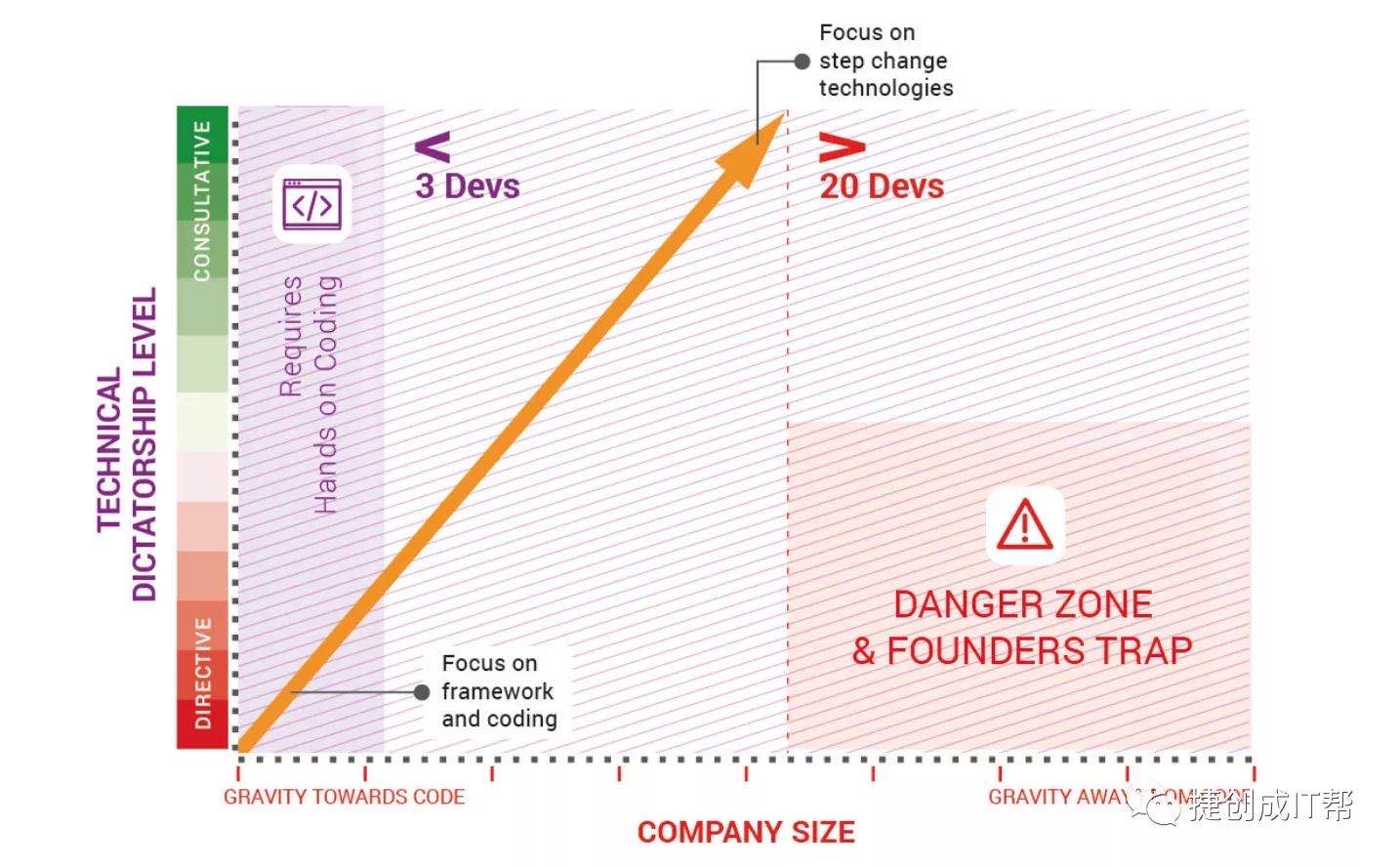One of the biggest challenges we face as we progress from technologist to CTO (or when hiring a new CTO) is how technical we need to be. The more senior the leadership role, the greater the pull away from technology. So how, then, do we remain technically competent as a CTO (or any other senior technical leadership role) in order to drive technology effectively? I believe the answer to this question relies on the following three components.
- Leadership styles
- Size and type of the organization
- Passion for technology
1. Leadership Styles
How we lead, or more explicitly, how direct we are when leading, is proportional to how technical we need to be. Figure 1 shows the Dictatorship Spectrum. On the left side, we operate in a dictatorial manner and therefore require high technical abilities. On the right side, we operate in an empowering and consultative manner, so our technical ability and currency can be reduced while remaining a high-performance technical leader.

That is, if we are going to prescribe solutions and strategies to our teams, we’d better be great at technology! But this isn’t an excuse to stay technical and directive; that just doesn’t scale to any size. The more people and teams under our leadership, the more consultative and empowering our leadership needs to be.
In the startup world, the small team size (typically less than 10) often means that the CTO spends a lot of time hands-on. There’s no other way around it; startup CTOs generally need to make a hands-on contribution. Conversely, as a CTO of a large organisation, our success is not determined by our hands-on contribution. Our role is to guide and shape long term, strategic enablement of the business and to grow the technical capability around us to the appropriate scale. Figure 2 demonstrates the combination of leadership style and company size as it relates to technical capability.

2. Size and Type of the Organisation
In a small organisation, gravity pulls us toward contributing directly, due to the lack of other technologists to build products. As the organisation scales, the leadership aspect of the role forces a shift, pulling us away from the technology. Being directive is required in small startups — it’s how things get done. However, as the organisation scales and pulls us away from the technology, we can’t stay technically sharp and be a competent leader, never mind a great one. If our style remains directive, we will enter the danger zone. We will burn out, act like a jackass, or slow down delivery performance to a snail’s pace, if not all of the above!
As we develop our leadership style away from directive, we consult the technical specialists in our teams for specific input and guidance. Rebecca Parsons, CTO of ThoughtWorks, utilises what they call a Technical Advisory Board (TAB). This board leverages the great minds and thought leadership of their global talent to provide direction and assistance to some of the world’s leading organisations.
By using a team of highly technical consultants, we can balance people leading and technical input in an appropriate way, leveraging their years of experience with technology and paradigms to challenge and ask questions that reveal the most appropriate solutions for the current context.
The type of organization (not just the size) also impacts the effectiveness of the technical leader. I define three organization types in descending order of required technical competence and currency:
- Technical startup
- Tech product or consultancy
- Non-tech organisation
Quite simply, if we are working for a technical organisation, we need to be more technically current than if we work for a non-technical organisation.
3. Passion for Technology
If we don’t have a passion and love for technology and creation, we won’t make the best digital leader, period. There’s no room in the digital leadership elite for people who a) have not come from a technology background and b) are no longer passionate about technology. Why? Because we are leading technologists. The best people to lead technologists are leaders who were technologists. They know how technologists work. They know when the wool is being pulled over their eyes, and they know what it’s like to be in the trenches.
If we aren’t passionate about technology, we probably won’t keep abreast of the latest tech trends and therefore will fail to understand both the tool and paradigm shifts happening around our teams. It’s all too easy for digital leaders to get busy and then turn around one day and see that the tech world has moved past what we understood. One can usually date the last time a digital leader was hands-on by the way they approach solutions and the paradigms they use.
Passionate digital leaders find time on the train, on weekends, or whenever, to “play” with technology. They seek to understand a new paradigm’s strengths and weaknesses and what it’s like for the teams that use it as a toolset. Great leaders carve out a portion of their week to pair with technologists. Not to guide them, quite the opposite. They seek to learn from the developers. Great CTO’s make a point of doing this each week with senior developers, to keep current and experience the coal face, the Gemba, where value is created.
It’s a challenging balance to maintain over time. A lot of leaders feel anxious about their diminishing technical skills, some are drawn back into the technology, and most ebb and flow as a natural cycle of being an agile and responsive leader. Find your balance, understand what’s needed, and be conscious of your technical dictatorship level.
转:HOW TECHNICAL SHOULD A CTO BE?
https://evolvingdigitalleadership.com/how-technical-should-a-cto-be/
